美国波多里奇- Malcolm Baldrige National Quality Award leadership model
- 格式:pdf
- 大小:102.76 KB
- 文档页数:9
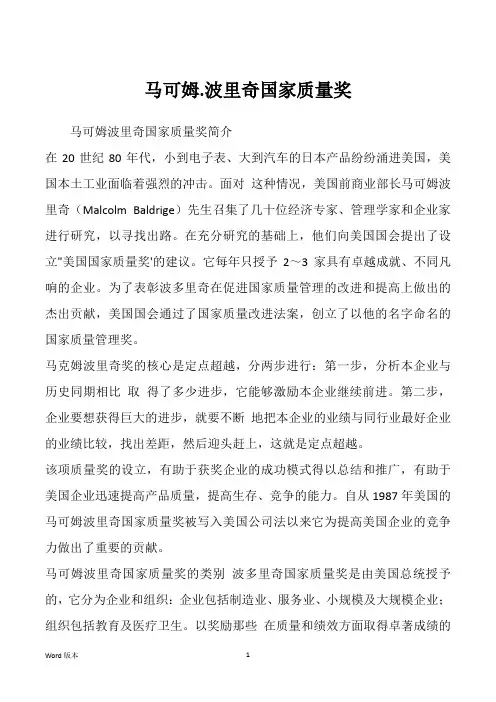
马可姆.波里奇国家质量奖马可姆波里奇国家质量奖简介在20世纪80年代,小到电子表、大到汽车的日本产品纷纷涌进美国,美国本土工业面临着强烈的冲击。
面对这种情况,美国前商业部长马可姆波里奇(Malcolm Baldrige)先生召集了几十位经济专家、管理学家和企业家进行研究,以寻找出路。
在充分研究的基础上,他们向美国国会提出了设立"美国国家质量奖'的建议。
它每年只授予2~3家具有卓越成就、不同凡响的企业。
为了表彰波多里奇在促进国家质量管理的改进和提高上做出的杰出贡献,美国国会通过了国家质量改进法案,创立了以他的名字命名的国家质量管理奖。
马克姆波里奇奖的核心是定点超越,分两步进行:第一步,分析本企业与历史同期相比取得了多少进步,它能够激励本企业继续前进。
第二步,企业要想获得巨大的进步,就要不断地把本企业的业绩与同行业最好企业的业绩比较,找出差距,然后迎头赶上,这就是定点超越。
该项质量奖的设立,有助于获奖企业的成功模式得以总结和推广,有助于美国企业迅速提高产品质量,提高生存、竞争的能力。
自从1987年美国的马可姆波里奇国家质量奖被写入美国公司法以来它为提高美国企业的竞争力做出了重要的贡献。
马可姆波里奇国家质量奖的类别波多里奇国家质量奖是由美国总统授予的,它分为企业和组织:企业包括制造业、服务业、小规模及大规模企业;组织包括教育及医疗卫生。
以奖励那些在质量和绩效方面取得卓著成绩的美国企业,并以此提高质量和绩效卓越作为竞争要素的重要性,及提高公众对质量和绩效卓越的认知。
波多里奇奖并不授予某项特定的产品和服务。
波多里奇国家质量奖和其获奖单位是美国质量改进可以看得见的榜样,并且围绕着波多里奇奖和其标准,形成了非常广泛的全国范围内的质量活动。
一份由私人竞争力顾问机构撰写的关于波多里奇奖的报告《21世纪的美国质量》(AERICAN quality for the 21st Century)中谈道:"比起其他的任何项目,美国波多里奇国家质量奖都更加注重于把质量做为国家和民族的最高优先级,在全国范围内推广质量改进及绩效卓越的典范,传播他们的做法。

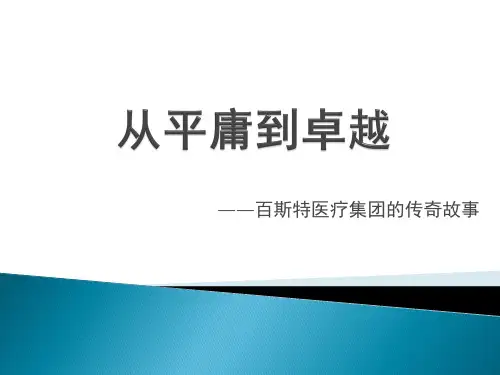
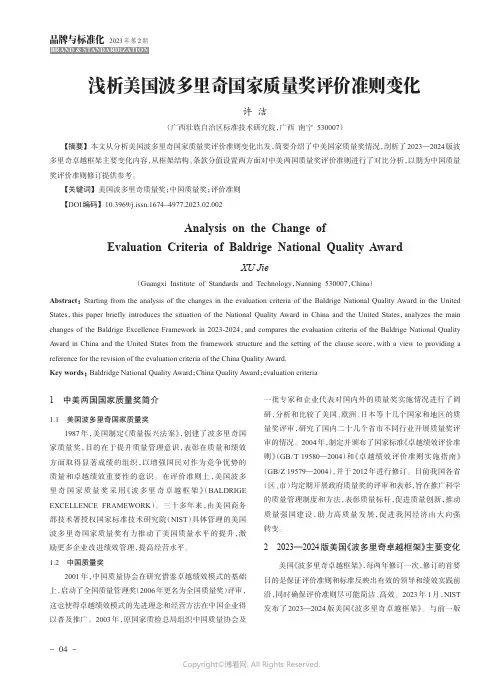
2023年第2期品牌与标准化Analysis on the Change ofEvaluation Criteria of Baldrige National Quality AwardXU Jie(Guangxi Institute of Standards and Technology ,Nanning 530007,China )Abstract :Starting from the analysis of the changes in the evaluation criteria of the Baldrige National Quality Award in the United States ,this paper briefly introduces the situation of the National Quality Award in China and the United States ,analyzes the main changes of the Baldrige Excellence Framework in 2023-2024,and compares the evaluation criteria of the Baldrige National Quality Award in China and the United States from the framework structure and the setting of the clause score ,with a view to providing a reference for the revision of the evaluation criteria of the China Quality Award.Key words :Baldridge National Quality Award ;China Quality Award ;evaluation criteria浅析美国波多里奇国家质量奖评价准则变化许洁(广西壮族自治区标准技术研究院,广西南宁530007)【摘要】本文从分析美国波多里奇国家质量奖评价准则变化出发,简要介绍了中美国家质量奖情况,剖析了2023—2024版波多里奇卓越框架主要变化内容,从框架结构、条款分值设置两方面对中美两国质量奖评价准则进行了对比分析,以期为中国质量奖评价准则修订提供参考。
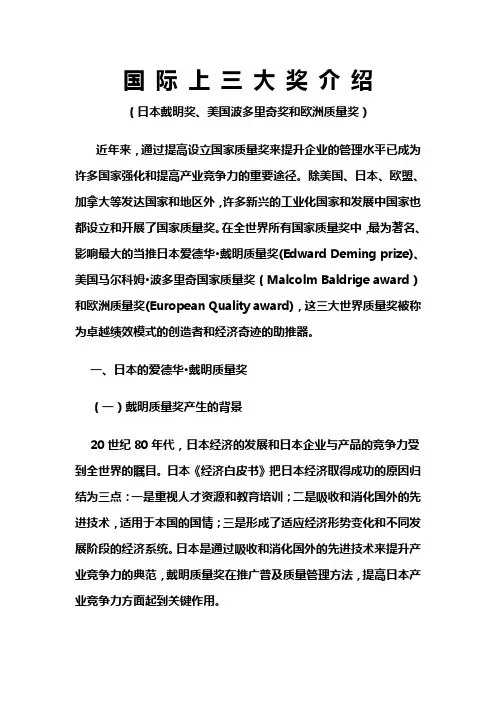
国际上三大奖介绍(日本戴明奖、美国波多里奇奖和欧洲质量奖)近年来,通过提高设立国家质量奖来提升企业的管理水平已成为许多国家强化和提高产业竞争力的重要途径。
除美国、日本、欧盟、加拿大等发达国家和地区外,许多新兴的工业化国家和发展中国家也都设立和开展了国家质量奖。
在全世界所有国家质量奖中,最为著名、影响最大的当推日本爱德华〃戴明质量奖(Edward Deming prize)、美国马尔科姆〃波多里奇国家质量奖(Malcolm Baldrige award)和欧洲质量奖(European Quality award),这三大世界质量奖被称为卓越绩效模式的创造者和经济奇迹的助推器。
一、日本的爱德华〃戴明质量奖(一)戴明质量奖产生的背景20世纪80年代,日本经济的发展和日本企业与产品的竞争力受到全世界的瞩目。
日本《经济白皮书》把日本经济取得成功的原因归结为三点:一是重视人才资源和教育培训;二是吸收和消化国外的先进技术,适用于本国的国情;三是形成了适应经济形势变化和不同发展阶段的经济系统。
日本是通过吸收和消化国外的先进技术来提升产业竞争力的典范,戴明质量奖在推广普及质量管理方法,提高日本产业竞争力方面起到关键作用。
美国的爱德华〃戴明博士最早把质量管理介绍到日本。
1949年日本科学技术联盟(JUSE)邀请戴明博士在日本举行为期八天的统计质量管理基础讲座.1951年,戴明博士在日本举行为期两个月的统计质量管理讲座,使当时处在幼年期的日本工业的质量控制得到了极大的推动。
JUSE把讲义印刷的版税支付给戴明,戴明没有接受这笔钱,并声称将其用于推进日本的质量管理活动.为了永久纪念戴明对日本人民的友情和贡献,日本科技联盟设立了爱德华〃戴明质量奖,用以推动日本工业质量控制和质量管理活动的发展。
随后,戴明博士的著作《样本分析》在日本出版,并且再次赠送了该书的版税.至今,JUSE仍然负责管理戴明质量奖的所有经费。
(二)戴明质量奖的评价标准戴明质量奖分为戴明奖、戴明应用奖和戴明控制奖。
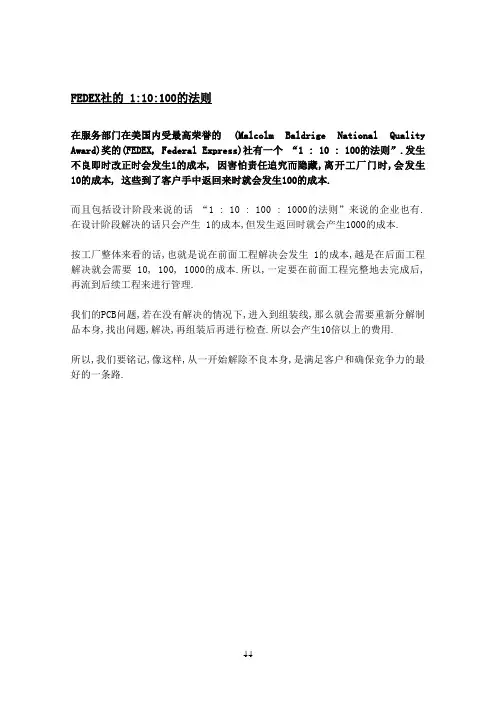
FEDEX社的 1:10:100的法则
在服务部门在美国内受最高荣誉的(Malcolm Baldrige National Quality Award)奖的(FEDEX, Federal Express)社有一个“1 : 10 : 100的法则”.发生不良即时改正时会发生1的成本, 因害怕责任追究而隐藏,离开工厂门时,会发生10的成本, 这些到了客户手中返回来时就会发生100的成本.
而且包括设计阶段来说的话“1 : 10 : 100 : 1000的法则”来说的企业也有.在设计阶段解决的话只会产生 1的成本,但发生返回时就会产生1000的成本.
按工厂整体来看的话,也就是说在前面工程解决会发生 1的成本,越是在后面工程解决就会需要 10, 100, 1000的成本.所以,一定要在前面工程完整地去完成后,再流到后续工程来进行管理.
我们的PCB问题,若在没有解决的情况下,进入到组装线,那么就会需要重新分解制品本身,找出问题,解决,再组装后再进行检查.所以会产生10倍以上的费用.
所以,我们要铭记,像这样,从一开始解除不良本身,是满足客户和确保竞争力的最好的一条路.
44。
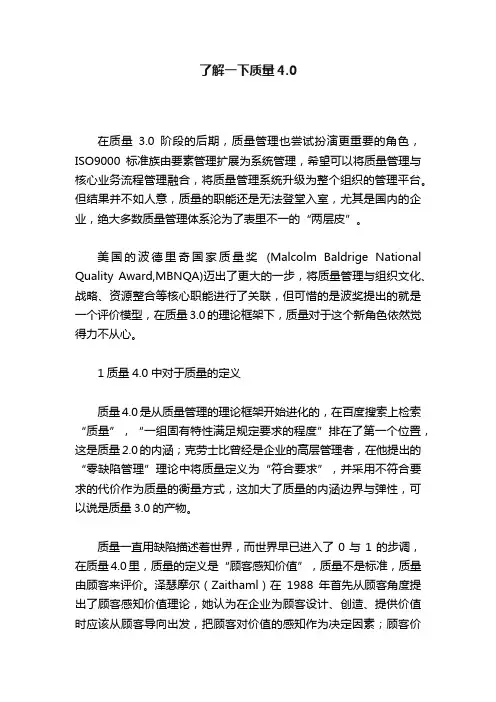
了解一下质量4.0在质量3.0阶段的后期,质量管理也尝试扮演更重要的角色,ISO9000标准族由要素管理扩展为系统管理,希望可以将质量管理与核心业务流程管理融合,将质量管理系统升级为整个组织的管理平台。
但结果并不如人意,质量的职能还是无法登堂入室,尤其是国内的企业,绝大多数质量管理体系沦为了表里不一的“两层皮”。
美国的波德里奇国家质量奖(Malcolm Baldrige National Quality Award,MBNQA)迈出了更大的一步,将质量管理与组织文化、战略、资源整合等核心职能进行了关联,但可惜的是波奖提出的就是一个评价模型,在质量3.0的理论框架下,质量对于这个新角色依然觉得力不从心。
1质量4.0中对于质量的定义质量4.0是从质量管理的理论框架开始进化的,在百度搜索上检索“质量”,“一组固有特性满足规定要求的程度”排在了第一个位置,这是质量2.0的内涵;克劳士比曾经是企业的高层管理者,在他提出的“零缺陷管理”理论中将质量定义为“符合要求”,并采用不符合要求的代价作为质量的衡量方式,这加大了质量的内涵边界与弹性,可以说是质量3.0的产物。
质量一直用缺陷描述着世界,而世界早已进入了0与1的步调,在质量4.0里,质量的定义是“顾客感知价值”,质量不是标准,质量由顾客来评价。
泽瑟摩尔(Zaithaml)在1988年首先从顾客角度提出了顾客感知价值理论,她认为在企业为顾客设计、创造、提供价值时应该从顾客导向出发,把顾客对价值的感知作为决定因素;顾客价值是由顾客而不是由供应企业决定的,顾客价值实际上就是顾客感知价值(Customer Perceived Value,CPV)。
在顾客体验至上的时代里,我们会有这样的经历,青花瓷残片没有任何的使用价值,用过去的质量标准来说就是废品,但却依然不影响喜欢她的顾客花高价趋之若鹜,一句话,顾客感知有价值,对于这个顾客群体就是有质量,否则你做的再精美也不过是没有质量的赝品。
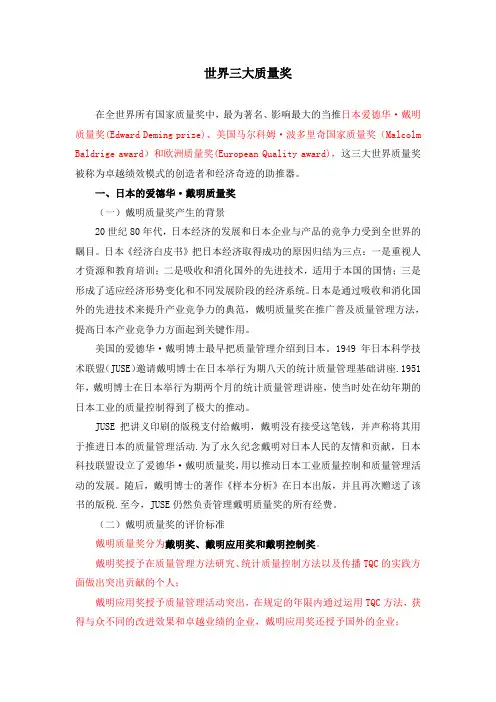
世界三大质量奖在全世界所有国家质量奖中,最为著名、影响最大的当推日本爱德华·戴明质量奖(Edward Deming prize)、美国马尔科姆·波多里奇国家质量奖(Malcolm Baldrige award)和欧洲质量奖(European Quality award),这三大世界质量奖被称为卓越绩效模式的创造者和经济奇迹的助推器。
一、日本的爱德华·戴明质量奖(一)戴明质量奖产生的背景20世纪80年代,日本经济的发展和日本企业与产品的竞争力受到全世界的瞩目。
日本《经济白皮书》把日本经济取得成功的原因归结为三点:一是重视人才资源和教育培训;二是吸收和消化国外的先进技术,适用于本国的国情;三是形成了适应经济形势变化和不同发展阶段的经济系统。
日本是通过吸收和消化国外的先进技术来提升产业竞争力的典范,戴明质量奖在推广普及质量管理方法,提高日本产业竞争力方面起到关键作用。
美国的爱德华·戴明博士最早把质量管理介绍到日本。
1949年日本科学技术联盟(JUSE)邀请戴明博士在日本举行为期八天的统计质量管理基础讲座.1951年,戴明博士在日本举行为期两个月的统计质量管理讲座,使当时处在幼年期的日本工业的质量控制得到了极大的推动。
JUSE把讲义印刷的版税支付给戴明,戴明没有接受这笔钱,并声称将其用于推进日本的质量管理活动.为了永久纪念戴明对日本人民的友情和贡献,日本科技联盟设立了爱德华·戴明质量奖,用以推动日本工业质量控制和质量管理活动的发展。
随后,戴明博士的著作《样本分析》在日本出版,并且再次赠送了该书的版税.至今,JUSE仍然负责管理戴明质量奖的所有经费。
(二)戴明质量奖的评价标准戴明质量奖分为戴明奖、戴明应用奖和戴明控制奖。
戴明奖授予在质量管理方法研究、统计质量控制方法以及传播TQC的实践方面做出突出贡献的个人;戴明应用奖授予质量管理活动突出,在规定的年限内通过运用TQC方法,获得与众不同的改进效果和卓越业绩的企业,戴明应用奖还授予国外的企业;戴明控制奖授予企业中的一个部门,这个部门通过使用TQC方法,在规定的年限内获得与众不同的卓越改进效果。
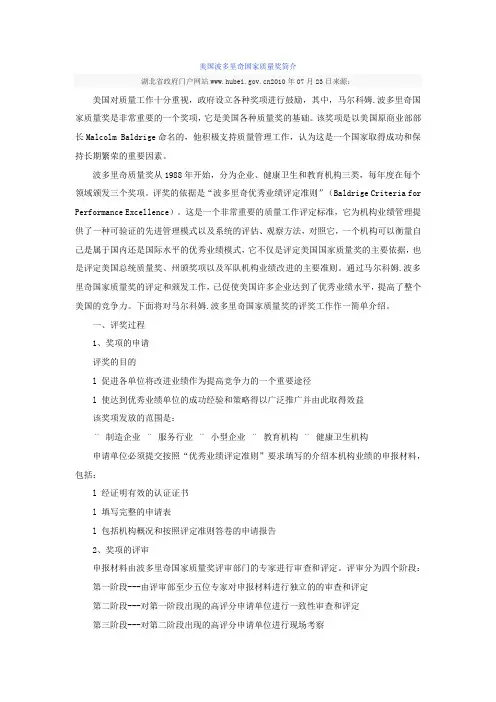
美国波多里奇国家质量奖简介湖北省政府门户网站2010年07月23日来源:美国对质量工作十分重视,政府设立各种奖项进行鼓励,其中,马尔科姆.波多里奇国家质量奖是非常重要的一个奖项,它是美国各种质量奖的基础。
该奖项是以美国原商业部部长Malcolm Baldrige命名的,他积极支持质量管理工作,认为这是一个国家取得成功和保持长期繁荣的重要因素。
波多里奇质量奖从1988年开始,分为企业、健康卫生和教育机构三类,每年度在每个领域颁发三个奖项。
评奖的依据是“波多里奇优秀业绩评定准则”(Baldrige Criteria for Performance Excellence)。
这是一个非常重要的质量工作评定标准,它为机构业绩管理提供了一种可验证的先进管理模式以及系统的评估、观察方法,对照它,一个机构可以衡量自己是属于国内还是国际水平的优秀业绩模式,它不仅是评定美国国家质量奖的主要依据,也是评定美国总统质量奖、州颁奖项以及军队机构业绩改进的主要准则。
通过马尔科姆.波多里奇国家质量奖的评定和颁发工作,已促使美国许多企业达到了优秀业绩水平,提高了整个美国的竞争力。
下面将对马尔科姆.波多里奇国家质量奖的评奖工作作一简单介绍。
一、评奖过程1、奖项的申请评奖的目的l 促进各单位将改进业绩作为提高竞争力的一个重要途径l 使达到优秀业绩单位的成功经验和策略得以广泛推广并由此取得效益该奖项发放的范围是:¨制造企业¨服务行业¨小型企业¨教育机构¨健康卫生机构申请单位必须提交按照“优秀业绩评定准则”要求填写的介绍本机构业绩的申报材料,包括:l 经证明有效的认证证书l 填写完整的申请表l 包括机构概况和按照评定准则答卷的申请报告2、奖项的评审申报材料由波多里奇国家质量奖评审部门的专家进行审查和评定。
评审分为四个阶段:第一阶段---由评审部至少五位专家对申报材料进行独立的的审查和评定第二阶段---对第一阶段出现的高评分申请单位进行一致性审查和评定第三阶段---对第二阶段出现的高评分申请单位进行现场考察第四阶段---由仲裁委员会最终评审,推荐获奖者名单3、申报奖项的信息反馈在评奖过程结束后,每一个申报单位都会收到评审部门的信息反馈报告。
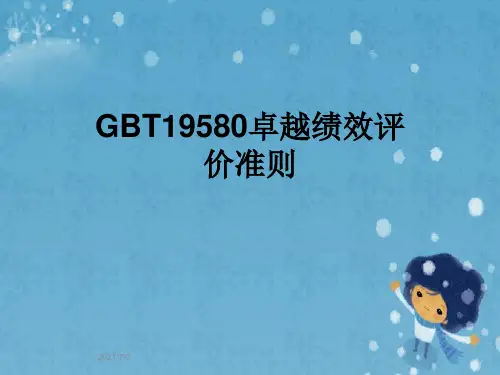
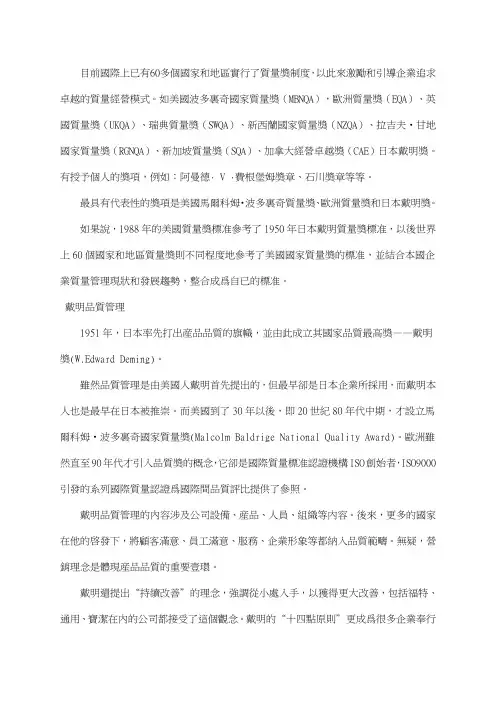
目前國際上已有60多個國家和地區實行了質量獎制度,以此來激勵和引導企業追求卓越的質量經營模式。
如美國波多裏奇國家質量獎(MBNQA),歐洲質量獎(EQA)、英國質量獎(UKQA)、瑞典質量獎(SWQA)、新西蘭國家質量獎(NZQA)、拉吉夫•甘地國家質量獎(RGNQA)、新加坡質量獎(SQA)、加拿大經營卓越獎(CAE)日本戴明獎。
有授予個人的獎項,例如:阿曼德· V ·費根堡姆獎章、石川獎章等等。
最具有代表性的獎項是美國馬爾科姆•波多裏奇質量獎、歐洲質量獎和日本戴明獎。
如果說,1988年的美國質量獎標准參考了1950年日本戴明質量獎標准,以後世界上60個國家和地區質量獎則不同程度地參考了美國國家質量獎的標准,並結合本國企業質量管理現狀和發展趨勢,整合成爲自已的標准。
戴明品質管理1951年,日本率先打出産品品質的旗幟,並由此成立其國家品質最高獎——戴明獎(W.Edward Deming)。
雖然品質管理是由美國人戴明首先提出的,但最早卻是日本企業所採用,而戴明本人也是最早在日本被推崇。
而美國到了30年以後,即20世紀80年代中期,才設立馬爾科姆•波多裏奇國家質量獎(Malcolm Baldrige National Quality Award)。
歐洲雖然直至90年代才引入品質獎的概念,它卻是國際質量標准認證機構ISO創始者,ISO9000引發的系列國際質量認證爲國際間品質評比提供了參照。
戴明品質管理的內容涉及公司設備、産品、人員、組織等內容。
後來,更多的國家在他的啓發下,將顧客滿意、員工滿意、服務、企業形象等都納入品質範疇。
無疑,營銷理念是體現産品品質的重要壹環。
戴明還提出“持續改善”的理念,強調從小處入手,以獲得更大改善,包括福特、通用、寶潔在內的公司都接受了這個觀念。
戴明的“十四點原則”更成爲很多企業奉行的圭臬,包括建立壹致的目標、持續而永久改善産品及服務、打破部門間障礙等。
2023—2024版波多里奇卓越框架介绍(一)1987年,时任美国总统里根签发《100-107公共法》,即马尔科姆•波多里奇国家质量改进法案。
以立法形式确立波多里奇卓越绩效项目,并设立马尔科姆•波多里奇国家质量奖(Malcolm Baldrige National Quality Award,MBNQA,以下简称“波奖”)。
波多里奇卓越绩效项目通过推动和鼓励各类组织采用稳健、领导力驱动和顾客导向的质量管理体系,帮助美国渡过了20世纪80年代的质量危机。
30多年来,该项目帮助美国制造、服务、医疗卫生、教育、政府、小企业和非营利组织取得了突出的经营绩效,包括收入和市场份额、员工参与和保留、社会和社区效益。
波奖也成为全球质量领域最具影响力的奖项之一,其采用的“卓越绩效评价准则”标准,代表了“被证明有效的领导和绩效管理实践最前沿”。
目前,世界上40多个国家和地区的质量奖评审等同采用该标准。
面对全球日益严峻复杂的经济和政治形势,美国商务部和国家标准与技术研究院(National Institute of Standards and Technology,NIST)为确保波多里奇卓越绩效项目能够更好地提升美国的竞争力,有效应对当今经营环境中最有意义的挑战,并提高该项目的影响力和可及性,2021年项目监督委员会进行了全面、独立的审查,并对项目提出系统改进建议。
为全面推进相关变革计划,确保项目产生预期影响,2022年波奖暂停评审。
虽然波奖评审暂停,但波多里奇卓越绩效项目2022年仍取得重要进展。
一是,波奖评审范围进一步扩大,继2007年纳入非营利组织之后,“社区”成为波奖的第七个类别,允许社区申请该奖项,对系统改善所有部门社区绩效的努力给予总统级别的认可,以共同实现更好的社区结果。
二是,发布《2023—2024版波多里奇卓越框架》,包括商业/非营利、教育、医疗卫生三个版本。
30多年来,卓越绩效准则(见图1)伴随着组织竞争力和长期成功驱动因素的变化而不断演进。
别了别了,,摩托罗拉摩托罗拉——————转载自转载自转载自《《商务周刊商务周刊》》仅仅在10年前,摩托罗拉还一直是引领尖端技术和卓越典范的代表,享有着全球最受尊敬公司之一的尊崇地位。
它一度前无古人地每隔10年便开创一个工业,有的10年还开创两个。
但当这些工业兴盛起来,进入寡头竞争的成熟阶段之后,它却遭遇一次又一次重大的挫败。
最近10年,它已经退出了自己所开创的半导体、汽车电子——这些业务在它的手上陷入困境,它一旦撒手往往又起死回生。
而最新的迹象显示,摩托罗拉很可能要放弃它的手机业务。
如果这个令人遗憾的消息真的变为现实,它将退守至两个狭小的B2G、B2B 市场,不再是一家B2C 公司。
这家美国“国宝级”公司究竟是如何走到今天这一步?史上最糟糕的星期5月9日,风雨飘摇的摩托罗拉股价以9.76美元收盘,总市值220.11亿美元,约为其股价最高点(按2000年分股后计算)58.33美元时的1/6。
自今年2月底跌破10美元之后,这家公司的股价始终徘徊在5年来的最低谷,营收也跌至4年来的新低。
即使是2000年网络泡沫破灭之后,它的股价也仅比现在低1美元左右。
而它的竞争对手诺基亚5月9日的市值是1088.72亿美元,年销售额约是其两倍。
当然,也许不久之后,诺基亚就将只是它“曾经的”对手了。
3月26日,摩托罗拉宣布将分拆为两家独立的上市公司,其中一家专注于移动通信设备业务,另一家则主要开展宽带和移动通信解决方案业务,分拆计划于2009年完成。
尽管在很多人的意料之中,但这条消息仍然是爆炸性的。
作为手机的发明者和移动通信10年前的霸主,这家公司终于要把自己最让人留恋的产品,弄丢了。
亲戚或余悲,他人亦已歌。
这样的分拆不仅会令卡尔·伊坎(Carl Icahn)为代表的摩托罗拉股东稍感遂愿,同样也会令其集群通信和机顶盒业务部门主管们松一口气,面向政府公共部门的集群通信业务去年赢利12亿美元,正好可以全被用来填补手机业务12亿美元的亏损。
世界三大质量奖介绍近年来,通过提高设立国家质量奖来提升企业的管理水平已成为许多国家强化和提高产业竞争力的重要途径。
目前有80多个国家和地区设立了质量奖,其中最具影响力和代表性的世界质量奖:美国波多里奇国家质量奖(Malcolm Baldrige award)、日本戴明奖(Edward Deming prize)、欧洲质量奖(European Quality award),这三大世界质量奖被称为卓越绩效模式的创造者和经济奇迹的助推器。
一、日本戴明质量奖(一)戴明质量奖产生的背景20世纪80年代,日本经济的发展和日本企业与产品的竞争力受到全世界的瞩目。
日本《经济白皮书》把日本经济取得成功的原因归结为三点:一是重视人才资源和教育培训;二是吸收和消化国外的先进技术,适用于本国的国情;三是形成了适应经济形势变化和不同发展阶段的经济系统。
日本是通过吸收和消化国外的先进技术来提升产业竞争力的典范,戴明质量奖在推广普及质量管理方法,提高日本产业竞争力方面起到关键作用。
美国的爱德华·戴明博士最早把质量管理介绍到日本。
1949年日本科学技术联盟(JUSE)邀请戴明博士在日本举行为期八天的统计质量管理基础讲座.1951年,戴明博士在日本举行为期两个月的统计质量管理讲座,使当时处在幼年期的日本工业的质量控制得到了极大的推动。
JUSE把讲义印刷的版税支付给戴明,戴明没有接受这笔钱,并声称将其用于推进日本的质量管理活动.为了永久纪念戴明对日本人民的友情和贡献,日本科技联盟设立了爱德华·戴明质量奖,用以推动日本工业质量控制和质量管理活动的发展。
随后,戴明博士的著作《样本分析》在日本出版,并且再次赠送了该书的版税.至今,JUSE仍然负责管理戴明质量奖的所有经费。
(二)戴明质量奖的评价标准戴明质量奖分为戴明奖、戴明应用奖和戴明控制奖。
戴明奖授予在质量管理方法研究、统计质量控制方法以及传播TQC的实践方面做出突出贡献的个人;戴明应用奖授予质量管理活动突出,在规定的年限内通过运用TQC方法,获得与众不同的改进效果和卓越业绩的企业,戴明应用奖还授予国外的企业;戴明控制奖授予企业中的一个部门,这个部门通过使用TQC方法,在规定的年限内获得与众不同的卓越改进效果。
世界三大质量奖与CQMA的比较分析近年来,质量管理在企业的重要性不断提升,同时,伴随着国际贸易的快速发展,国际质量标准和奖项也得到了越来越广泛的认可,其中比较著名的有日本的“日本质量奖”、美国的“马耳他X奖”和欧洲的“欧洲质量奖”。
而作为我国企业的主要竞争手段,中国质量管理协会(CQMA)也推出了自己的质量奖项,以下从多个维度对世界三大质量奖和CQMA的比较分析进行详细介绍。
质量标准日本质量奖是基于日本质量管理标准JIS Q 9001为基础,结合日本管理理念,注重质量管理的全过程,并将其拓展到企业外部,注重对供应商和顾客的关系管理,是日本对企业的综合评价体系。
马耳他X奖(Malcolm Baldrige National Quality Award)是美国政府颁发的全国性质量奖项,其基于极信任度的管理方式,注重决策的科学化和改进质量的创新模式,鼓励企业创新并推广其优秀的质量管理模式。
欧洲质量奖(EFQM)是欧盟颁发的最高荣誉质量奖项,注重企业内部的全面管理,其评价体系被认为是市场经济国家服务管理的标准,制造业和非制造业企业均可参与。
CQMA优秀质量管理奖是中国最早一批的质量奖项之一,主要评价标准是基于ISO9001体系,将企业的质量管理、企业与社会的关系以及企业成长和可持续发展整合到一个完整的统计模型当中。
可以看到,三大质量奖都很注重质量标准的制定,主要依据国家标准和企业实践要求,而CQMA的质量标准主要与ISO 9001标准相似,符合国际质量要求。
评价体系三大质量奖的评价体系以及要求,主要体现在以下几个方面:日本质量奖:强调在企业质量管理过程中,要广泛地吸收工人和职员的各种意见和建议,促进企业各个部门之间的协调和合作,提高企业的综合效益以及提高企业的客户满意度。
马耳他X奖:注重全面评价企业的管理体系,通过各种讨论和实地检查,全面检查从管理体系、发展规划、员工关系、客户关系、产品创新、质量成果等各个方面,全面测评企业的管理水平以及质量水平。
波多里奇国家质量奖获得者(1988年到2009年, 其中一些奖项在某些年度空缺).Malcolm Baldrige National Quality Award Winners2009 (5)Honeywell Federal Manufacturing & TechnologiesKansas City, Mo. (manufacturing)MidwayUSAColumbia, Mo. (small business)AtlantiCareEgg Harbor Township, N.J. (health care)Heartland HealthSt. Joseph, Mo. (health care)VA Cooperative Studies Program Clinical Research Pharmacy Coordinating Center Albuquerque, N.M. (nonprofit)2008 (3)Cargill Corn Milling North AmericaWayzata, Minn. (manufacturing)Poudre Valley Health SystemFt. Collins, Colo. (health care)Iredell-Statesville SchoolsStatesville, N.C. (education)2007 (5)PRO-TEC Coating Co.Leipsic, Ohio (small business)Mercy Health SystemsJanesville, Wisc. (health care)Sharp HealthCareSan Diego, Calif. (health care)City of Coral SpringsCoral Springs, Fla. (nonprofit)U.S. Army Armament Research, Development and Engineering Center (ARDEC)Picatinny Arsenal, N.J. (nonprofit)2006 (3)MESA Products, Inc.Tulsa, Okla. (small business)Premier Inc.San Diego, Calif. (service)North Mississippi Medical CenterTupelo, Miss. (health care)2005 (6)Sunny Fresh Foods, Inc.Monticello, Minn. (manufacturing)DynMcDermott Petroleum OperationsNew Orleans, La. (service)Park Place LexusPlano, Texas (small business)Richland CollegeDallas, Texas (education)Jenks Public SchoolsJenks, Okla. (education)Bronson Methodist HospitalKalamazoo, Mich. (health care)2004 (4)The Bama CompaniesTulsa, Okla. (manufacturing)Texas Nameplate Company, Inc.Dallas, Texas (small business)Kenneth W. Monfort College of BusinessGreeley, Colo. (education)Robert Wood Johnson University Hospital HamiltonHamilton, N.J. (health care)2003 (7)Medrad, Inc.Indianola, Pa. (manufacturing)Boeing Aerospace SupportSt. Louis, Mo. (service)Caterpillar Financial Services Corp.Nashville, Tenn. (service)Stoner Inc.Quarryville, Pa. (small business)Community Consolidated School District 15Palatine, Ill. (education)Baptist Hospital, Inc.Pensacola, Fla. (health care)Saint Luke’s Hospital of Kansas CityKansas City, Mo. (health care)2002 (3)Motorola Inc. Commercial, Government and Industrial Solutions Sector Schaumburg, Ill. (manufacturing)Branch-Smith Printing DivisionFort Worth, Texas (small business)SSM Health CareSt. Louis, Mo. (health care)2001 (5)Clarke American Checks, Incorporated San Antonio, Texas (manufacturing)Pal’s Sudden ServiceKingsport, Tenn. (small business) Chugach School DistrictAnchorage, Alaska (education)Pearl River School DistrictPearl River, N.Y. (education)University of Wisconsin-Stout Menomonie, Wis. (education)2000 (4)Dana Corp.-Spicer Driveshaft Division Toledo, Ohio (manufacturing)KARLEE Company, Inc.Garland, Texas (manufacturing) Operations Management International, Inc. Greenwood Village, Colo. (service)Los Alamos National BankLos Alamos, N.M. (small business)1999 (4)STMicroelectronics, Inc.-Region Americas Carrollton, Texas (manufacturing)BI Performance ServicesMinneapolis, Minn. (service)The Ritz-Carlton Hotel Company, L.L.C. Atlanta, Ga. (service)Sunny Fresh FoodsMonticello, Minn. (small business)1998 (3)Boeing Airlift and Tanker ProgramsLong Beach, Calif. (manufacturing)Solar Turbines Inc.San Diego, Calif. (manufacturing)Texas Nameplate Company Inc.Dallas, Texas (small business)1997 (4)3M Dental Products DivisionSt. Paul, Minn. (manufacturing)Solectron Corp.Milpitas, Calif. (manufacturing)Merrill Lynch Credit Corp.Jacksonville, Fla. (service)Xerox Business ServicesRochester, N.Y. (service)1996 (4)ADAC LaboratoriesMilpitas, Calif. (manufacturing)Dana Commercial Credit Corp.Toledo, Ohio (service)Custom Research Inc.Minneapolis, Minn. (small business)Trident Precision Manufacturing Inc.Webster, N.Y. (small business)1995 (2)Armstrong World Industries’ Building Products Operation Lancaster, Pa. (manufacturing)Corning Telecommunications Products Division Corning, N.Y. (manufacturing)1994 (3)AT&T Consumer Communications ServicesBasking Ridge, N.J. (service)GTE Directories Corp.Dallas/Ft. Worth, Texas (service)Wainwright Industries Inc.St. Peters, Mo. (small business)1993 (2)Eastman Chemical Co.Kingsport, Tenn. (manufacturing)Ames Rubber Corp.Hamburg, N.J. (small business)1992 (5)AT&T Network Systems Group/TransmissionSystems Business UnitMorristown, N.J. (manufacturing)Texas Instruments Inc.Defense Systems & Electronics Group Dallas, Texas (manufacturing)AT&T Universal Card Services Jacksonville, Fla. (service)The Ritz-Carlton Hotel Co.Atlanta, Ga. (service)Granite Rock Co.Watsonville, Calif. (small business) 1991 (3)Solectron Corp.Milpitas, Calif. (manufacturing)Zytec Corp.Eden Prairie, Minn. (manufacturing) Marlow IndustriesDallas, Texas (small business)1990 (4)Cadillac Motor Car DivisionDetroit, Mich. (manufacturing)IBM RochesterRochester, Minn. (manufacturing) Federal Express Corp.Memphis, Tenn. (service)Wallace Co. Inc.Houston, Texas (small business) 1989 (2)Milliken & Co.Spartanburg, S.C. (manufacturing) Xerox Corp.Business Products and Systems Rochester, NY (manufacturing)1988 (3)Motorola Inc.Schaumburg, Ill. (Manufacturing) Commercial Nuclear Fuel Division of Westinghouse Electric Corp. Pittsburgh, Pa. (manufacturing) Globe Metallurgical Inc.Beverly, Ohio (small business)。
Malcolm Baldrige National Quality Award leadership modelVictor Prybutok andRobert CutshallVictor Prybutok is based at the Department of Business Computer Information Systems,College of Business Administration,University of North Texas,Denton,Texas,USA. Robert Cutshall is based at the College of Business,Texas A&M University–Corpus Christi,Corpus Christi,Texas,USA.Baldrige Award,Leadership,Modelling,Quality assessmentIn this study,a Malcolm Baldrige National Quality Award (MBNQA)criteria-based survey was used to assess the quality status of organizations that employ quality professionals.The objective was to focus on the relationship between leadership (LS),information and analysis,human resource planning,process quality,and customer focus.The result was the development of an MBNQA-based model that demonstrated the relationship between executive LS and the MBNQA factors.The Emerald Research Register for this journal isavailable at/researchregisterThe current issue and full text archive of this journal is available at/0263-5577.htm IntroductionUS organizations are using quality improvement techniques to produce higher quality products and services at significantly reduced costs.Studies (T anner et al.,1995)show that the cost savings associated with quality improvements often occur early,within3years,in the long term quality management effort.Hence,actively managing quality is helping US organizations to become more competitive in the global market (Scheuermann et al.,1997).Consistent with the application of quality improvement techniques is the assessment of quality and evaluation of the internal and external customers’perception of quality.In this study,a Malcolm Baldrige National Quality Award (MBNQA)criteria-based survey was used to assess the quality status of organizations that employ quality professionals.An MBNQA-based survey,of American Society for Quality(ASQ) Dallas Section,was conducted to measure the perceptions of quality among quality professionals and to measure the relationships among the MBNQA dimensions.Specifically,this work focuses on the relationship between leadership (LS),information and analysis(IA),human resource(HR)planning,process quality(PQ),and customer focus(CF).The sample selected for this study comprised of ASQ quality professionals.As a result of the expertise of the respondents,this data set provides an unique insight into the relationships among the dimensions that compose quality in an organization.Developing a measurement instrument is an important step in assessing the quality,or perception of quality,of an organization(Bemowski and Stratton,1995;Black and Porter,1996;Prybutok and Stafford,1997). Hence,exploration of the relationships in the MBNQA as measured by the instrument we developed was the main objective of this work. Factor analysis and regression models were used to explore the relationships among the MBNQA and LS dimensions in the MBNQA quality framework. Malcolm Baldrige National Quality Award The United States Department of Commerce (1998)created the MBNQA in1987to enhance competitiveness(Bell and Keys,1998;Decarlo and Sterett,1990).Specific goals of the award include promoting awareness of the relationship between quality and competitiveness,increasing understanding about the level of quality required to achieve world class recognition,and fostering the sharing of information about quality by world class organizations(Bemowski,1995;BemowskiIndustrial Management&Data SystemsVolume104·Number7·2004·pp.558–566q Emerald Group Publishing Limited·ISSN0263-5577 DOI10.1108/02635570410550223and Stratton,1995).One of the most frequent uses of the MBNQA criteria is for self assessment (Bemowski and Stratton,1995;Black and Porter, 1996;Reimann,1989;Vokurka,2001;Wu et al., 1997).Self-assessment is important because it helps an organization to define its quality system and select customer driven quality objectives (Reimann,1989).The MBNQA criteria consists of which are seven functionally related major categories listed below and each of these major categories are further divided for a total of32 subcategories.(1)LS is the category that embodies all otherMBNQA criteria(Sullivan,1992).(2)IA is the category that supports all of theother categories(Forza,1995;Omdahl,1992).(3)Strategic quality planning examines theorganization’s strategic business planningand implementation processes(Marquardt,1992).(4)HR development and planning analyzes theprocess by which an organization developsand realizes the full potential of its work force(Leifield,1992).(5)Management of PQ addresses design,production,support systems,supplierquality,and quality assessment(Heaphy,1992).(6)Quality and operational results assess how anorganization is performing in areas that areultimately important to the customer and inidentifying trends in those areas(Case andBigelow,1992).(7)CF and satisfaction focus on how anorganization manages its customers(Desatnick,1992).These categoriesfit into a framework composed of four basic elements:(1)driver,(2)system,(3)measures of progress,and(4)goal.The1999MBNQA criteria lists senior executive LS as the driver that creates values,goals,and systems that guide the pursuit of quality objectives (Bell and Keys,1998;Sullivan,1992).Processes such as information analysis,strategic quality planning,HR development and planning,and management of PQ provide the system needed by senior management to measure progress with quality and operational results.Based on the analysis of the information provided by the measure of progress,senior management can determine if the goal of customer satisfaction has been achieved.Research objectivesThe research objective of this work is to explore the relationships between LS and the other dimensions of the MBNQA.This study reports the analysis related specifically to survey items that elicited responses about the quality processes of several organizations in different industries. Data collectionThere is a need for instrument development and research that empirically contributes to the development of TQM practices and self-assessment frameworks for organizations(Black and Porter,1996;Wu et al.,1997).Therefore,a quality practices assessment instrument was developed by using the content of each of the major MBNQA criterion and writing items requiring either a Likert style(strongly disagree to strongly agree)or to leave the item blank if it is not applicable.This approach parallels the development of Prybutok and Spink’s(1999) MBNQA instrument for parison of the two instruments shows their similarity and strengthens the validity of this instrument.Each item was designed to reflect one aspect of the MBNQA criteria.Quality experts,including a MBNQA lead assessor,a T exas quality award examiner,and several certified quality engineers, reviewed the initial survey for content validity. Two of these survey evaluators had worked for MBNQA winners.After incorporating many of the suggested changes,the survey was reviewed again by the experts.The survey was administered to members of the ASQ,Dallas Section.The members surveyed ranged from CEOs to senior staff members.The industries represented ranges from electronics and other electronic equipment and components, to nondepository credit institutions.Out of the89 surveys distributed at a Dallas section meeting62were returned.Though some respondents occasionally left a response blank,most of the items had62respondents.The limitations imposed by the sample were not critical to this work because the intent of this work was to explore the relationships among the MBNQA dimensions and not to describe the views of ASQ members. Data analysisFactor analysisFactor analysis is a multivariate statistical method that identifies the extent to which the responses tothe items in the survey have common variances (Hair et al.,1995).Factor analysis was used to determine the interdependence between variables and allows definition or confirmation of conceptualized dimensions(Churchill,1979).In this study factor analysis was used to determine the groupings(factors)of the items in the instrument to each of the MBNQA dimensions. The goal was to obtain a unidimensional measure for each of the seven dimensions.A principal components factor analysis was used to analyze survey Items1-7as they related to senior executive LS,which is the drive for the othersix factors.Survey items:senior executive LSThe responses to seven survey items,which related to the perceptions of executive LS,were analyzed in this study.The items were as follows.(1)Item1.My company has a strong set ofquality values that is applied consistentlythroughout all facets of the organization. (2)Item2.In my company quality goals are atleast as important asfinancial goals.(3)Item3.T op management promotescooperation among managers andsupervisors across different levels anddifferent functions of the organization. (4)Item4.My company evaluates performancewith regard to quality of all functions of theorganization on a regular basis.(5)Item5.T op management in my company isconcerned with the organization’s impact onthe external community on the followingissues:health and safety.(6)Item6.T op management in my company isconcerned with the organization’s impact onthe external community on the followingissue:environmental protection.(7)Item7.T op management in my company isconcerned with the organization’s impact onthe external community on the followingissue:ethical business practices.ResultsFactor analysisT able I focuses on the results from a factor analysis of Items1-7that related to senior executive LS issues,and shows the factor loadings for each item. Items5and6were removed from the analysis because they did not load cleanly on any factor (over0.5loading on one factor and less than0.5on all others(Hair et al.,1995)),but rather loaded on several factors.T able I shows that after elimination of these two items the factor analysis produced a unidimensional measure of LS.The factor loadings revealed that the itemsgrouped into four related factors represent uniquedimensions of quality:Factor1:HR development and managementT able II shows the ten items loaded onto thisfactor.These items represent a MBNQAdimension that focuses on the respondentsperceptions of HR plans derived from a strategicquality plan,well-defined management practicesused to promote individual employee and teamcontributions to quality objectives,monitoring theextent and involvement by all levels of employees,formal quality training,performancemeasurement,recognition,and reward,maintaining a work environment conducive toemployee growth,and monitoring employeesatisfaction.(1)Item20.My company has HR plans derivedfrom the strategic quality plan that are aimedat achieving the full potential of the workforce.(2)Item21.My company has well-definedmanagement practices and otherTable I Factor loadingsVariables Factor1Factor2 Item1.My company has a strongset of quality values that is appliedconsistently throughout all facetsof the organization0.87520.124 Item2.In my company quality goals areat least as important asfinancial goals0.79320.400 Item3.Top management promotescooperation among managers andsupervisors across different levelsand different functions of theorganization0.82620.313 Item4.My company evaluates performancewith regard to quality of all functions ofthe organization on a regular basis0.74420.344 Item5.Top management in mycompany is concerned withthe organization’s impact on theexternal community on thefollowing issue:health and safety0.5030.807 Item6.Top management in mycompany is concerned with theorganization’s impact on the externalcommunity on the following issue:environmental protection0.4660.809 Item7.Top management in my companyis concerned with the organization’simpact on the external communityon the following issue:ethicalbusiness practices0.7240.218 Eigenvalue 3.3680.744 Variance explained67.3514.88mechanisms(i.e.awards or suggestionsystems or similar)that are used to promote individual employee contributions to quality objectives.(3)Item22.My company has well-definedmanagement practices and othermechanisms(i.e.work teams or qualitycircles or similar)that are used to promoteteam contributions to quality objectives. (4)Item23.My company monitors the extentand effectiveness of involvement by allcategories and levels of employees.(5)Item24.All employees in my companyreceive formal quality training in theknowledge and skills required for them tomeet the quality objectives associated withtheir responsibilities.(6)Item25.My company has systems thatsupport recognition as a quality objective. (7)Item26.My company has systems thatsupport rewards as a quality objective. (8)Item27.My company has systems thatsupport performance measurement as aquality objective.(9)Item28.My company maintains a workenvironment conducive to the well-being andgrowth of all employees.(10)Item29.My company regularly monitorsemployee satisfaction and uses the resultsto support its quality improvement efforts. Factor2:CF and satisfactionT able III shows the12items that were loaded on this factor.This factor represents a MBNQA dimensions about the degree of CF and satisfaction achieved within an organization.The dimension includes components that focus on seeking to determine the quality expectations of the customer,the effectiveness of customer management,the ability to measure CF,and how the organization compares on its customer satisfaction with competitors,industry averages, industry leaders,and world leaders.(1)Item46.My company has a formal methodfor determining current quality requirementsand expectations of customers.(2)Item47.My company has a formal methodfor determining future quality requirementsand expectations of customers.(3)Item48.My company has a formal methodfor determining product and service featuresdesired by the customer and/or customergroups.(4)Item49.My company has a formal methodfor evaluating the relative importance ofproduct and/or service features to itscustomers.(5)Item50.My company provides effectivecustomer management.(6)Item51.My company continuously improvesits customer management practices.(7)Item52.My company has objective servicestandards against which service quality ismeasured.(8)Item53.My company makes both implicitand explicit commitments that promote trustand confidence from its customers.(9)Item54.My company resolves customercomplaints promptly and effectively. (10)Item55.My company formally analyzescustomer complaints to determine theirunderlying causes in order to make necessaryimprovements in products and services. (11)Item56.My company formally examinescustomer complaints in order to makenecessary improvements to its processes. (12)Item57.My company measures and analyzestrends and current levels of customersatisfaction.(13)Item58.My company compares its customersatisfaction results with principalcompetitors.Table II Factor loadings for HRs development and managementVariables Factor1 Item20.My company has HR plans derived fromthe strategic quality plan that are aimed atachieving the full potential of the work force0.794 Item21.My company has well defined managementpractices and other mechanisms(i.e.awards orsuggestion systems or similar)that are used topromote individual employee contributionsto quality objectives0.825 Item22.My company has well-defined managementpractices and other mechanisms(i.e.work teams orquality circles or similar)that are used to promoteteam contributions to quality objectives0.711 Item23.My company monitors the extent and effectivenessof involvement by all categories and levels of employees0.759 Item24.All employees in my company receive formalquality training in the knowledge and skills requiredfor them to meet the quality objectives associatedwith their responsibilities0.658 Item25.My company has systems that supportrecognition as a quality objective0.875 Item26.My company has systems that supportrewards as a quality objective0.908 Item27.My company has systems that supportperformance measurement as a quality objective0.775 Item28.My company maintains a work environmentconducive to the well-being and growth of all employees0.791 Item29.My company regularly monitors employeesatisfaction and uses the results to support itsquality improvement efforts0.849 Eigenvalue 6.361 Variance explained63.615(14)Item59.My company compares its customersatisfaction results with industry averages.(15)Item60.My company compares its customersatisfaction results with industry leaders. (16)Item61.My company compares its customersatisfaction results with world leaders. Factor3:management of PQT able IV shows the nine items that were loaded onto factor3.This factor represents a MBNQA dimension that is related to the designs in customer requirements,quality issues in the early design phase,analyzing process capabilities, monitoring the processes used to produce products and services,continuously improving the processes used to produce products and services.(1)Item30.My company has a systematicmethod for introducing new products andservices which include designs in customerrequirements.(2)Item31.My company has a systematicmethod for introducing new products andservices which address quality issues early in the design phase.(3)Item32.My company has a systematicmethod for introducing new products andservices which analyze process capabilities.(4)Item33.My company monitors the processesused to produce products and services inorder to identify when they are out-of-control and make necessary corrections. (5)Item34.My company continuously improvesthe processes used to produce its productsand services.(6)Item35.My company formally assesses thequality of its systems.(7)Item36.My company formally assesses thequality of its processes and practices.Variables Factor1Factor2Factor3 Item46.My company has a formal method for determiningcurrent quality requirements and expectations of customers0.75120.08620.373 Item47.My company has a formal method for determiningfuture quality requirements and expectations of customers0.8260.03820.297 Item48.My company has a formal method for determiningproduct and service features desired by the customerand/or customer groups0.75520.11220.444 Item49.My company has a formal method for evaluatingthe relative importance of product and/or servicefeatures to its customers0.77020.09720.405 Item50.My company provides effective customer management0.67420.3320.388 Item51.My company continuously improves its customermanagement practices0.76620.1600.249 Item52.My company has objective service standards againstwhich service quality is measured0.79020.2210.102 Item53.My company makes both implicit and explicit commitmentsthat promote trust and confidence from its customers0.71320.4530.300 Item54.My company resolves customer complaintspromptly and effectively0.62120.4610.364 Item55.My company formally analyzes customer complaintsto determine their underlying causes in order to makenecessary improvements in products and services0.81320.2900.076 Item56.My company formally examines customer complaintsin order to make necessary improvements to its processes0.78820.2350.062 Item57.My company measures and analyzes trendsand current levels of customer satisfaction0.82020.05420.327 Item58.My company compares its customer satisfactionresults with principal competitors0.6230.7020.156 Item59.My company compares its customer satisfactionresults with industry averages0.6290.7010.025 Item60.My company compares its customer satisfactionresults with industry leaders0.6310.7150.249 Item61.My company compares its customer satisfactionresults with world leaders0.6210.7320.139 Eigenvalue8.489 2.806 1.257 Variance explained53.05517.5377.853(8)Item37.My company formally assesses thequality of its products and services.(9)Item38.My company maintainsdocumentation and other modes ofknowledge preservation and transfer,tosupport its quality assurance,assessment,and improvement efforts.(10)Item39.My company’s quality requirementsare communicated to all external suppliers ofgoods and services.(11)Item40.My company has methods in placeto evaluate the quality of goods and servicessupplied by external suppliers and guaranteethat they satisfy all quality requirements. (12)Item41.My company monitors trends andcurrent levels for key measures of productand service quality.Factor4:IAT able V shows the seven items that were loaded onto factor4.Factor4represents a MBNQA dimension that is focused on the respondents’perceptions of their organizations’storage, transfer,and use of information.(1)Item8.There are well-documented processesand techniques used to ensure reliability. (2)Item9.There are well-documented processesand techniques used to ensure consistency.(3)Item10.There are well-documentedprocesses and techniques used to ensurereview.(4)Item11.There are well-documentedprocesses and techniques used to ensuretimely update.(5)Item12.My company regularly performscomparisons of its quality processes to world-class benchmarks to support qualityplanning,evaluation and improvement. (6)Item13.Quality data and informationgathered internally are systematicallyanalyzed to help support the company’soverall quality objectives.(7)Item14.Quality data and informationgathered externally are systematicallyanalyzed to help support the company’soverall quality objectives.Variables Factor1Factor2Factor3 Item30.My company has a systematic method forintroducing new products and services which includedesigns in customer requirements0.52520.3710.385 Item31.My company has a systematic method forintroducing new products and services which addressquality issues early in the design phase0.80520.47320.031 Item32.My company has a systematic methodfor introducing new products and serviceswhich analyze process capabilities0.72820.48220.290 Item33.My company monitors the processes used to produceproducts and services in order to identify when they areout-of-control and make necessary corrections0.82920.15720.241 Item34.My company continuously improves the processesused to produce its products and services0.75520.10920.505 Item35.My company formally assesses the quality of its systems0.6930.55320.223 Item36.My company formally assesses the qualityof its processes and practices0.6970.49820.286 Item37.My company formally assesses the qualityof its products and services0.7630.1840.068 Item38.My company maintains documentation and othermodes of knowledge preservation and transfer,to supportits quality assurance,assessment,and improvement efforts0.6560.3720.384 Item39.My company’s quality requirements are communicatedto all external suppliers of goods and services0.74920.1820.279 Item40.My company has methods in place to evaluatethe quality of goods and services supplied by external suppliersand guarantee that they satisfy all quality requirements0.7400.0620.335 Item41.My company monitors trends and current levels for keymeasures of product and service quality0.8020.1410.258 Eigenvalue 6.442 1.413 1.086 Variance explained53.68011.7789.046MBNQA factors that were excluded from this modelT able VI shows thefive items that were loaded onto the strategic quality planning dimension of the MBNQA.The strategic quality planning dimension is focused on the respondents’perceptions of their organizations’strategic planning process and strategic plans.(1)Item15.My company has a well-definedshort-term(1-2years)strategic qualityplanning process to help maintain quality LSin the marketplace.(2)Item16.My company has a well-definedstrategic plan to increase customersatisfaction.(3)Item17.My company has a strategic qualityplan that details how we will pursue marketLS through providing superior qualityproducts and services.(4)Item18.My company has a strategic qualityplan that details how we will pursue marketLS through improving the effectiveness of alloperations of the company.(5)Item19.My company’s strategic quality planhas specific goals and strategies thateffectively address issues impacting futurequality for key product and quality features. While these items were all loaded onto one factor, the strategic quality planning factor was notsignificant in the LS model.Hence,this factor was removed from the model via stepwise regression.T able VII shows the four items that were loaded onto the quality and operational results factor of the MBNQA.The four items are as follows.(1)Item42.My company objectively comparesits current quality levels with principalcompetitors.(2)Item43.My company objectively comparesits current quality levels with industryleaders.(3)Item44.My company objectively comparesits current quality levels with world leaders.(4)Item45.My company monitors trends andcurrent levels for the most importantindicators of supplier quality.The quality and operational results factor were not significant in the LS model as presented in this study,but this could result in multicollinearity among the factors.Regression analysisThis analysis was conducted to explore the relationship between senior executive LS and the six other MBNQA dimensions.For each dimension a unidimensional measure was created by removing items that did not specifically load onto one factor.The linear sums of each of theTable V Factor loadings for IAVariables Factor1 Item8.There are well-documented processesand techniques used to ensure reliability0.822 Item9.There are well-documented processesand techniques used to ensure consistency0.843 Item10.There are well-documented processesand techniques used to ensure review0.879 Item11.There are well-documented processesand techniques used to ensure timely update0.863 Item12.My company regularly performs comparisonsof its quality processes to world-class benchmarksto support quality planning,evaluation and improvement0.799 Item13.Quality data and information gathered internallyare systematically analyzed to help supportthe company’s overall quality objectives0.692 Item14.Quality data and information gathered externallyare systematically analyzed to help supportthe company’s overall quality objectives0.707 Eigenvalue 4.521 Variance explained64.591Table VI Factor loadings for strategic quality planningVariables Factor1 Item15.My company has a well-defined short-term(1-2years)strategic quality planning process to helpmaintain quality LS in the marketplace0.851 Item16.My company has a well-defined strategicplan to increase customer satisfaction0.903 Item17.My company has a strategic quality plan thatdetails how we will pursue market LS throughproviding superior quality products and services0.891 Item18.My company has a strategic quality plan thatdetails how we will pursue market LS through improvingthe effectiveness of all operations of the company0.863 Item19.My company’s strategic quality plan has specificgoals and strategies that effectively address issuesimpacting future quality levels for key productand quality features0.830 Eigenvalue 3.767 Variance explained75.340Table VII Factor loadings for quality and operational resultsVariables Factor1 Item42.My company objectively compares its currentquality levels with principal competitors0.907 Item43.My company objectively compares its currentquality levels with industry leaders0.950 Item44.My company objectively compares itscurrent quality levels with world leaders0.879 Item45.My company monitors trends and current levelsfor the most important indicators of supplier quality0.731 Eigenvalue 3.030 Variance explained75.759。